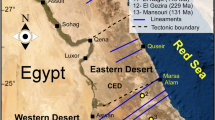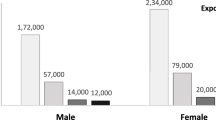Abstract
Radon gas (222Rn) is a natural constituent of the environment and a risk factor for lung cancer that we are exposed to as a result of radioactive decay of radium (226Ra) in stone and soil. Granite countertops, in particular, have received recent media attention regarding their potential to emit radon. Radon flux was measured on 39 full slabs of granite from 27 different varieties to evaluate the potential for exposure and examine determinants of radon flux. Flux was measured at up to six pre-selected locations on each slab and also at areas identified as potentially enriched after a full-slab scan using a Geiger–Muller detector. Predicted indoor radon concentrations were estimated from the measured radon flux using the CONTAM indoor air quality model. Whole-slab average emissions ranged from less than limit of detection to 79.4 Bq/m2/h (median 3.9 Bq/m2/h), similar to the range reported in the literature for convenience samples of small granite pieces. Modeled indoor radon concentrations were less than the average outdoor radon concentration (14.8 Bq/m3; 0.4 pCi/l) and average indoor radon concentrations (48 Bq/m3; 1.3 pCi/l) found in the United States. Significant within-slab variability was observed for stones on the higher end of whole slab radon emissions, underscoring the limitations of drawing conclusions from discrete samples.
This is a preview of subscription content, access via your institution
Access options
Subscribe to this journal
Receive 6 print issues and online access
$259.00 per year
only $43.17 per issue
Buy this article
- Purchase on Springer Link
- Instant access to full article PDF
Prices may be subject to local taxes which are calculated during checkout




Similar content being viewed by others
References
al-Jarallah M. Radon exhalation from granites used in Saudi Arabia. J Environ Radioact 2001: 53 (1): 91–98.
al-Jarallah M.I., Abu-Jarad F., and Fazal-ur-Rehman Determination of radon exhalation rates from tiles using active and passive techniques. Radiat Meas 2001: 34: 491–495.
al-Jarallah M.I., Fazal-ur-Rehman, Musazay M.S., and Aksoy A. Correlation between radon exhalation and radium content in granite samples used as construction material in SaudiArabia. Radiat Meas 2005: 40: 625–629.
Arafa W. Specific activity and hazards of granite samples collected from the Eastern Desert of Egypt. J Environ Radioact 2004: 75 (3): 315–327.
ASHRAE. 2005 ASHRAE Handbook—Fundamentals [SI Edition]. American Society of Heating, Refrigerating, and Air-Conditioning Engineers, Atlanta, GA, USA, 2005.
Chao C.Y., and Tung T.C. Radon emanation of building material--impact of back diffusion and difference between one-dimensional and three-dimensional tests. Health Phys 1999: 76 (6): 675–681.
de Jong P., van Dijk W., van der Graaf E.R., and de Groot T.J. National survey on the natural radioactivity and 222Rn exhalation rate of building materials in The Netherlands. Health Phys 2006: 91 (3): 200–210.
Ek C.W., Onisko S.A., and Gregg G.O. Air leakage tests of manufactured housing in the Northwest United States. In: Sherman M.H. (Ed.). Air Change Rate and Airtightness in Buildings, ASTM STP 1067. American Society for Testing and Materials, Philadelphia, PA, USA, 1990, pp. 152–164.
El-Dine N.W., El-Shershaby A., Ahmed F., and Abdel-Haleem A.S. Measurement of radioactivity and radon exhalation rate in different kinds of marbles and granites. Appl Radiat Isot 2001: 55 (6): 853–860.
European Commission . In: European Commission. Directorate-General - Environment Nuclear Safety and Civil Protection (Ed.). Radiation Protection 112: Radiological Protection Principles Concerning The Natural Radioactivity Of Building Materials. European Commission, 1999: Finland.
Fazal ur R., Al-Jarallah M.I., Musazay M.S., and Abu-Jarad F. Application of the can technique and radon gas analyzer for radon exhalation measurements. Appl Radiat Isot 2003: 59 (5–6): 353–358.
Grimsrud D.T., Modera M.P., and Sherman M.H. A predictive air infiltration model-long-term field test validation. Semi-Annu Meet ASHRAE 1982: 1: 1351–1372.
ICRP. 2005 Recommendations of the International Commission on Radiological Protection: Summary of the Recommendations (Draft). International Commission on Radiological Protection (ICRP), Stockholm, 2005.
Ingersoll J.G. A survey of radionuclide contents and radon emanation rates in building materials used in the U.S. Health Phys 1983: 45 (2): 363–368.
Khan A.J., Prasad R., and Tyagi R.K. Measurement of radon exhalation rate from some building materials. Nucl Tracks Radiat Meas 1992: 20 (4): 609–610.
Kobeissi M.A., El Samad O., Zahraman K., Milky S., Bahsoun F., and Abumurad K.M. Natural radioactivity measurements in building materials in Southern Lebanon. J Environ Radioact 2008: 99: 1279–1288.
Lee S.C., Kim C.K., Lee D.M., and Kang H.D. Natural radionuclides contents and radon exhalation rates in building materials used in South Korea. Radiat Prot Dosimetry 2001: 94 (3): 269–274.
MacIntosh D., Minegishi T., Kaufman M., Baker B., Allen J., Levy J., and Myatt T. The benefits of whole-house in-duct air cleaning in reducing exposures to fine particulate matter of outdoor origin: a modeling analysis. J Expo Sci Environ Epidemiol 2009, advance online publication, 25 March 2009; doi:10.1038/jes.2009.16.
Maged A.F., and Ashraf F.A. Radon exhalation rate of some building materials used in Egypt. Environ Geochem Health 2005: 27 (5-6): 485–489.
Marcinowski F., Lucas R.M., and Yeager W.M. National and regional distributions of airborne radon concentrations in US homes. Health Phys 1994: 66 (6): 699–706.
Mustonen R. Natural radioactivity in and radon exhalation from Finnish building materials. Health Phys 1984: 46 (6): 1195–1203.
Myatt T.A., Minegishi T., Allen J.G., and Macintosh D.L. Control of asthma triggers in indoor air with air cleaners: a modeling analysis. Environ Health 2008: 7: 43.
Myatt T.A., Allen J.G., Minegishi T., McCarthy W.B., and MacIntosh D.L. Assessing exposure to radiation from granite countertops. J Expo Sci Environ Epidemiol 2009 (Submitted).
NCRP. Radiation Exposure of the US Population from Consumer Products and Miscellaneous Sources. National Council on Radiation Protection and Measurements (NCRP), Bethesda, MD, 1987a.
NCRP. Exposure of the Population in the United States and Canada from Natural Background Radiation. National Council on Radiation Protection and Measurements (NCRP), Bethesda, MD, 1987b.
NCRP. Limitation of Exposure to Ionizing Radiation. National Council on Radiation Protection and Measurements (NCRP), Bethesda, MD, 1993.
Ngachin M., Garavaglia M., Giovani C., Nourreddine A., Kwato Njock M.G., Scruzzi E., and Lagos L. (226)Ra, (232)Th and (40)K contents and radon exhalation rate from materials used for construction and decoration in Cameroon. J Radiol Protect 2008: 28 (3): 369–378.
Osmanlioglu A.E. Natural radioactivity and evaluation of effective dose equivalent of granites in Turkey. Radiat Prot Dosimetry 2006: 121 (3): 325–329.
Palmiter L, and Brown I Northwest Residential Infiltration Survey: Analysis and Results. Ecotope for Washington State Energy Office, Seattle, WA, USA, 1989, 52.
Parker GB, McSorley M, and Harris J The Northwest residential infiltration survey: a field study of ventilation in new homes in the Pacific Northwest. In: Sherman M.H. (Ed.). Air Change Rate and Airtightness in Buildings, ASTM STP 1067. ASTM International, 1990: Richmond, WA, pp. 93–103.
Petropoulos N.P., Anagnostakis M.J., and Simopoulos S.E. Photon attenuation, natural radioactivity content and radon exhalation rate of building materials. J Environ Radioact 2002: 61 (3): 257–269.
Sahoo B.K., Nathwani D., Eappen K.P., Ramachandran T.V., Gaware J.J., and Mayya Y.S. Estimation of radon emanation factor in Indian building materials. Radiat Meas 2007: 42: 1422–1425.
Singh H., Singh J., Singh S., and Bajwa B.S. Radon exhalation rate and uranium estimation study of some soil and rock samples from Tusham ring complex, India using SSNTD technique. Radiat Meas 2008: 43 (Supplement 1): S459–S462.
Sonkawade R.G., Kant K., Muralithar S., Kumar R., and Ramola R.C. Natural radioactivity in common building construction and radiation shielding materials. Atmos Environ 2008: 42: 2254–2259.
Stoulos S., Manolopoulou M., and Papastefanou C. Assessment of natural radiation exposure and radon exhalation from building materials in Greece. J Environ Radioact 2003: 69 (3): 225–240.
Stranden E. Building materials as a source of indoor radon, Chapter 3. In: Nazaroff W.W, and Nero A.V. (Eds.). Radon and Its Decay Products in Indoor Air. John Wiley & Sons, New York, NY, 1988.
Sundar S.B., Ajoy K.C., Dhanasekaran A., Gajendiran V., and Santhanam R. Measurement of radon exhalation rate from Indian granite tiles. 2003 Int Radon Symp 2003: II: 78–103.
US EPA. Radon Mitigation Standards. US Environmental Protection Agency, 1993: Washington, DC.
Walton G., and Dols W.S. CONTAM 2.1 Supplemental user guide and program documentation. National Institute of Standards and Technology, Gaithersberg, MD, 2003.
Acknowledgements
Funding for this research was provided by the Marble Institute of America, Cleveland, OH, and the Environmental Health and Engineering, Needham, MA. We thank John D. Spengler, Ph.D., Akira Yamaguchi Professor of Environmental Health and Human Habitation, Harvard School of Public Health, Helen H. Suh, Sc.D., Associate Professor of Environmental Chemistry and Exposure Assessment, Harvard School of Public Health, and Brian J. Baker, Senior Engineer, EH&E, for their contributions.
Author information
Authors and Affiliations
Corresponding author
Rights and permissions
About this article
Cite this article
Allen, J., Minegishi, T., Myatt, T. et al. Assessing exposure to granite countertops—part 2: Radon. J Expo Sci Environ Epidemiol 20, 263–272 (2010). https://doi.org/10.1038/jes.2009.43
Received:
Revised:
Accepted:
Published:
Issue Date:
DOI: https://doi.org/10.1038/jes.2009.43



